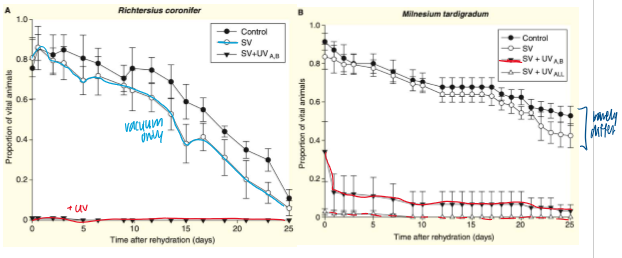E155 What Have We Learned From Taking Animals Into Space?
1/16
There's no tags or description
Looks like no tags are added yet.
Name | Mastery | Learn | Test | Matching | Spaced |
|---|
No study sessions yet.
17 Terms
What is the main focus of rodent research in space?
How microgravity environments impact organ systems (ex - bone loss, genes, molecules, and cells)
Health and recovery, impacts of radiation, aging, reproduction, cardiovascular health, fluid balance
Introduction: What are some challenges for using animal models in space?
size, longevity, care
What is a tardigrade? Where are they found?
Microscopic animals related to arthropods, living in sea from littoral to abyssal depth, in freshwater and terrestrial habitats at all latitudes, longitudes, and altitudes
What is cryptobiosis?
Cryptobiosis: most terrestrial species are able to suspend their metabolism completely and consequently their active life at any stage of their life-cycle (active or cryptobiotic)
Metabolic activities are suspended due to absence of liquid water
Induced by desiccation, freezing, high solute concentration, and absence of oxygen
type of hibernation
Tardigrade tolerances to extreme conditions. What extremes can tardigrades tolerate?
Radiation tolerance
Long-term survival: Survive up to 9 - 20 years under atmospheric conditions
Temperature extremes: Survival in temperatures close to absolute 0
Chemical extremes: resist exposure to CO2, hydrogen sulphide, and 1-hexanol
Pressure extremes: resist low and high hydrostatic pressures
Radiation extremes: withstand x-rays and other high radiations
Tardigrades as an animal model for space biology. Why are tardigrades a good animal model?
Have complex biological characteristics to research space induced stress
Do not need large hardware facilities
Short biological cycles
Constant number of cells
Withstand extreme conditions
After a week in space, mice start running around their habitat as if they were on running wheels back on Earth. What are some other normal habits that the mice exhibited in space?
Locomotion similar to hindlimb unloading
Running around the cage like they are running on the wheel
Self-grooming and eating
The article that accompanies the video, describes how tardigrades survive dessication. How are tardigrades similar to other examples of osmotic stress survival that we’ve seen in this class (e.g. frozen frogs or deep sea fish)? How are tardigrades different?
Similar: able to come back to life after being “dead;” genes that create proteins to maintain survival during desiccation to preserve their cells during desiccation (TDPs)
Different: do not use a type of sugar, like glucose, as the anti-freezing substance;
vomit comet
simulated space travel on reduced gravity aircraft
why are tardigrades good for space research
eggs are ressitant to environmental stress (acan dehydrate and rehydrate)
eat microbes, nematodes, other tardigrades
anyhydrobiosis
without, H2O, life
crybiosis: freeze tolerance
osmobiosis: osmolarity tolerance
anoxybiosis: no O2
tardigrades in space
desicated adults spent 10 days in space with 3 groups: space vacuum, SV and UV(a,b), and SV and UV(all)
when they were all brought back to Earth and rehydrated in a lab, barely a difference between the control and SV in proportion of vital animals

are tardigrade eggs radiation tolerant
yes, still high survival rates at high radiation
anhydrobiotic levels were significantly higher than the hydrated ones (indicates resistance)

heat shock protein 70
HSP70
under stress, normal proteins unravel
HSP70 restores the denaturing protein to a normal, wound protein
impact of heat shock proteins
flexibility in stress response due to lots of protein isoforms (applies to all stages and different proteins)
active nomal
transition during dessication
14 days in cryptobiosis
transition to rehydration
rehydrated, active

antioxidants
gets rid of free-radicals
increased antioxidant activity in dessicated species

ideal animal models for space research
small, reproduce easily, easy care
understanding of microgravity on animal-microbe interactions